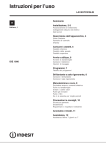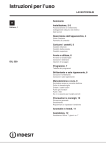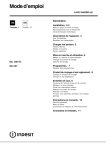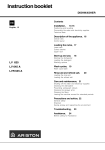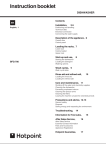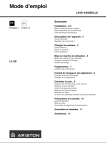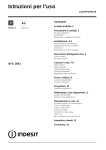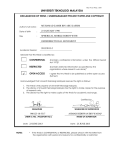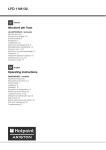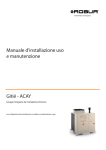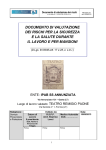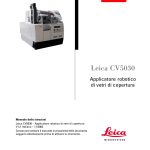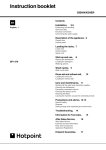Download Istruzioni per l`uso
Transcript
Istruzioni per luso LAVASTOVIGLIE IT Italiano, 1 EN English, 13 Sommario Installazione, 2-3 Posizionamento e livellamento Collegamenti idraulici ed elettrici Dati tecnici Descrizione dellapparecchio, 4 Vista d’insieme Pannello di controllo Caricare i cestelli, 5 Cestello inferiore Cestello delle posate Cestello superiore Avvio e utilizzo, 6 IDL 600 Avviare la lavastoviglie Caricare il detersivo Opzioni di lavaggio Programmi, 7 Tabella dei programmi Brillantante e sale rigenerante, 8 Caricare il brillantante Caricare il sale rigenerante Manutenzione e cura, 9 Escludere acqua e corrente elettrica Pulire la lavastoviglie Evitare i cattivi odori Pulire gli irroratori Pulire i filtri Se ci si assenta per lunghi periodi Precauzioni e consigli, 10 Sicurezza generale Smaltimento Risparmiare e rispettare l’ambiente Anomalie e rimedi, 11 Assistenza, 12 Assistenza Attiva 7 giorni su 7 Installazione IT È importante conservare questo libretto per poterlo consultare in ogni momento. In caso di vendita, di cessione o di trasloco, assicurarsi che resti insieme all’apparecchio. Leggere attentamente le istruzioni: ci sono importanti informazioni sull’installazione, sull’uso e sulla sicurezza. In caso di trasloco tenere l’apparecchio in posizione verticale; se fosse necessario, inclinarlo sul lato posteriore. Posizionamento e livellamento 1. Disimballare l’apparecchio e controllare che non abbia subìto danni durante il trasporto. Se fosse danneggiato non collegarlo e contattare il rivenditore. 2. Sistemare la lavastoviglie facendo aderire i fianchi o lo schienale ai mobili adiacenti o alla parete. L’apparecchio può anche essere incassato sotto a un piano di lavoro continuo (vedi foglio di Montaggio*). Collegamento del tubo di carico dellacqua • A una presa d’acqua fredda: avvitare bene il tubo di carico a un rubinetto con bocca filettata da 3/4 gas; prima di avvitare, far scorrere l’acqua finché non sia limpida affinché le eventuali impurità non intasino l’apparecchio. • A una presa d’acqua calda: nel caso di impianto centralizzato di termosifoni, la lavastoviglie può essere alimentata con acqua calda di rete purché non superi la temperatura di 60°C. Avvitare il tubo al rubinetto come descritto per la presa d’acqua fredda. Se la lunghezza del tubo di carico non è sufficiente, rivolgersi a un negozio specializzato o a un tecnico autorizzato (vedi Assistenza). La pressione dell’acqua deve essere compresa nei valori riportati dalla tabella Dati tecnici (vedi sotto). Fare attenzione che nel tubo non ci siano né pieghe né strozzature. Sicurezza antiallagamento 3. Posizionare la lavastoviglie su un pavimento piano e rigido. Compensare le irregolarità svitando o avvitando i piedini finché l’apparecchio non sia orizzontale (non deve essere inclinato più di 2 gradi). Un accurato livellamento dà stabilità ed evita vibrazioni, rumori e spostamenti. Collegamenti idraulici ed elettrici L’adattamento degli impianti elettrici e idraulici per l’installazione deve essere eseguito solo da personale qualificato. La lavastoviglie non deve appoggiare sui tubi o sul cavo di alimentazione elettrica. I tubi di carico (A) e di scarico (B) dell’acqua e il cavo di alimentazione elettrica possono essere orientati verso destra o sinistra per consentire la migliore installazione (vedi figura). Per garantire che non si generino allagamenti, la lavastoviglie: - è dotata di un sistema che interrompe l’ingresso dell’acqua nel caso di anomalie o di perdite dall’interno. - è dotata di sicurezza Water Stop *, cioè è provvista di un tubo di carico dell’acqua costituito da un tubo esterno trasparente e da uno interno rosso: entrambi i tubi sopportano pressioni molto alte. In caso di rottura del tubo interno, quello esterno si colora di un rosso vivo e convoglia l’acqua al posto di quello interno, evitando perdite. È molto importante controllare periodicamente il tubo esterno: se lo si vede rosso vivo, deve essere cambiato al più presto dall’Assistenza tecnica autorizzata (vedi Assistenza). * Presente solo su alcuni modelli. 2 Collegamento del tubo di scarico dellacqua Collegare il tubo di scarico, senza piegarlo, a una conduttura di scarico con diametro minimo di 4 cm. Oppure appoggiarlo al bordo di un lavandino o di una vasca; l’estremità libera del tubo di scarico non deve rimanere immersa nell’acqua. Il cavo deve essere controllato periodicamente e sostituito solo da tecnici autorizzati ( vedi Assistenza). IT L’Azienda declina ogni responsabilità qualora queste norme non vengano rispettate. Avvertenze per il primo lavaggio Lo speciale gomito* in plastica agevola una sistemazione ottimale: fissare saldamente il gomito al muro per evitare che il tubo si muova e versi l’acqua fuori dallo scarico. La parte del tubo contrassegnata con la lettera A deve essere a un’altezza compresa tra 40 e 100 cm da terra (vedi figura). A Dopo l’installazione, immediatamente prima del primo lavaggio, riempire completamente d’acqua il serbatoio del sale e aggiungere circa 2 Kg di sale ( vedi Brillantante e sale rigenerante): è normale che l’acqua trabocchi. È normale anche che dopo il caricamento del sale la spia MANCANZA SALE* continui a lampeggiare per alcuni cicli. Caratteristiche tecniche È sconsigliato usare tubi di prolunga. Collegamento elettrico Dimensioni Larghezza cm. 60 Altezza cm. 85 Profondità cm. 60 Prima di inserire la spina nella presa della corrente, accertarsi che: Capacità 12 coperti standard • la presa abbia la messa a terra e sia a norma di legge; Pressione acqua alimentazione 30 Kpa ÷ 1Mpa (0.3 ÷ 10 bar) 4,3 psi – 145 psi • la presa sia in grado di sopportare il carico massimo di potenza della macchina, indicato nella targhetta caratteristiche sulla controporta ( vedi Descrizione della lavastoviglie); Tensione di alimentazione vedi targhetta caratteristiche Potenza totale assorbita vedi targhetta caratteristiche Fusibile vedi targhetta caratteristiche • la tensione di alimentazione sia compresa nei valori indicati nella targhetta caratteristiche sulla controporta; • la presa sia compatibile con la spina dell’apparecchio. In caso contrario richiedere la sostituzione della spina a un tecnico autorizzato ( vedi Assistenza); non usare prolunghe o prese multiple. Ad apparecchio installato, il cavo di alimentazione elettrica e la presa della corrente devono essere facilmente raggiungibili. Questa apparecchiatura è conforme alle seguenti Direttive Comunitarie: -73/23/EEC del 19/02/73 (Bassa Tensione) e successive modifiche -89/336/EEC del 03/05/89 (Compatibilità Elettromagnetica) e successive modificazioni -97/17/EC (Etichettatura) -2002/96/CE Il cavo non deve subire piegature o compressioni. * Presente solo su alcuni modelli. 3 Descrizione dellapparecchio IT Vista dinsieme 1 3 2 4 1. 2. 3. 4. 5. 6. 7. 8. 9. 10. 11. Cestello superiore Irroratore superiore Ribaltine Regolatore altezza cestello Cestello inferiore Irroratore inferiore Cestello posate Filtro lavaggio Serbatoio sale Vaschette detersivo e serbatoio brillantante Targhetta caratteristiche 5 6 9 7 8 10 11 Pannello di controllo Tasto AVVIO RITARDATO* Spie AVANZAMENTO CICLO e AVVIO RITARDATO* Spia MANCANZA SALE* Spia MANCANZA BRILLANTANTE * Tasto START/RESET Tasto ON-OFF Spia ON-OFF Manopola Selezione PROGRAMMA * Presente solo su alcuni modelli. 4 Caricare i cestelli Prima di caricare, eliminare dalle stoviglie i residui di cibo, mettere in ammollo pentole e padelle incrostate, vuotare bicchieri e coppe dei liquidi rimasti. Dopo aver caricato, controllare che gli irroratori ruotino liberamente. Se il cestello è dotato di maniglie click clack* (vedi figura ), tirarle in su o in giù per regolare l’altezza. Cestello inferiore Sistemarvi le stoviglie più difficili da lavare secondo gli Esempi di caricamento e avvalendosi dei supporti ribaltabili*. • Piatti da portata e coperchi: ai lati del cestello. • Pentole e insalatiere: sempre capovolte. • Stoviglie molto fonde: in posizione obliqua. Per garantire migliori prestazioni di lavaggio e asciugatura, la superficie del cestello inferiore è più ruvida di quello superiore. Esempi di caricamento cestello superiore Cestello delle posate Il cestello delle posate può essere di tipo diverso a seconda dei modelli di lavastoviglie. I coltelli e gli utensili appuntiti devono essere sistemati nel cestello delle posate con la punta rivolta verso il basso. Esempi di caricamento cestello inferiore Ribaltine Just you ** Per dividere in due il corpo centrale*: sfilare la maniglia. Le due alette laterali* si possono staccare e agganciare al cestello superiore o inferiore. I due elementi a griglia* si inseriscono sul cestello per tenere separate le posate: inserirle nelle feritoie con i manici verso il basso. Cestello superiore Caricarvi le stoviglie delicate e leggere: bicchieri, tazze da tè e caffè, piattini, insalatiere basse, padelle, pentole basse poco sporche, secondo gli Esempi di caricamento. • Stoviglie leggere: sistemarle in modo che non vengano spostate dai getti d’acqua. • Tazze e tazzine: posizionarli sulle ribaltine**. • Coltelli lunghi e acuminati, posate di servizio: posizionarli sulle ribaltine**. Regolare laltezza del cestello superiore Per agevolare la sistemazione delle stoviglie, è possibile sistemare il cestello superiore in posizione alta o bassa: 1 aprire i fermi delle guide del 2 cestello a destra e a sinistra ed estrarre il cestello; sistemarlo in alto o in basso, farlo scivolare 3 lungo le guide fino a far entrare 4 anche le rotelle anteriori e chiudere i fermi ( vedi figura). Queste speciali ribaltine servono per sistemare tazze e tazzine.Cucchiai, forchette e coltelli vanno inseriti apposite fessure.I bicchieri a calice possono essere appesi inserendo il gambo nelle fessure. Stoviglie non adatte al lavaggio in lavastoviglie • Oggetti di legno, con impugnatura in legno, in corno, con parti incollate o non espressamente indicati per il lavaggio in lavastoviglie. • Oggetti di alluminio, rame, ottone, peltro o stagno. • Stoviglie di plastica non termoresistente. • Porcellane antiche o dipinte a mano. • Argenteria antica. L’argenteria non antica può invece essere lavata con un programma delicato e accertandosi che non sia a contatto con altri metalli. Si consiglia l’acquisto di stoviglie idonee al lavaggio in lavastoviglie. Lavaggio delle maniglie* Per lavare le maniglie dei cestelli inferiore e superiore: estrarre i due tappini di fissaggio, sfilare le maniglie, lavarle sotto l’acqua corrente e fissarle sul cestello con i tappini. * Presente solo in alcuni modelli. ** Variabili per numero e posizione. 5 IT Avvio e utilizzo Avviare la lavastoviglie IT 1. Aprire il rubinetto dell’acqua. 2. Premere il tasto ON-OFF: la spia si illumina. 3. Aprire la porta e dosare il detersivo (vedi sotto). 4. Caricare i cestelli (vedi Caricare i cestelli) e chiudere la porta. 5. Ruotare la manopola in senso orario per impostare il tipo di lavaggio desiderato in base alle stoviglie e al loro grado di sporco (vedi tabella dei programmi). 6. Selezionare le opzioni di lavaggio (vedi sotto). 7. Avviare premendo il tasto START/RESET: si sente un bip di conferma. Le spie AVANZAMENTO CICLO segnalano lo stato del programma: Prelavaggio, Lavaggio, Risciacquo, Asciugatura. 8.Al termine del lavaggio si sentono tre brevi segnali acustici e lampeggia la spia dell’ASCIUGATURA. 9.Spegnere l’apparecchio premendo il tasto ON-OFF, chiudere il rubinetto dell’acqua e staccare la spina dalla presa di corrente. 10. Aprire la porta e aspettare alcuni minuti prima di togliere le stoviglie, per evitare di scottarsi. Scaricare i cestelli iniziando da quello inferiore. Modificare un programma in corso Se si è selezionato un programma sbagliato è possibile modificarlo, purché appena iniziato: tenere premuto il tasto START/RESET per 4 secondi. Dopo un bip lungo e tre brevi, la spia AVANZAMENTO CICLO si spegne: selezionare il nuovo programma ruotando la manopola in senso antiorario e avviare premendo il tasto START/RESET. Aggiungere altre stoviglie Premere il tasto ON/OFF, aprire la porta facendo attenzione alla fuoriuscita di vapore e inserire le stoviglie. Premere di nuovo il tasto ON-OFF: il ciclo riprende. Interruzioni accidentali Se durante il lavaggio si apre la porta o si verifica un’interruzione di corrente, il lavaggio si interrompe. Riprende dal punto in cui si era interrotto quando si chiude la porta o torna la luce. Caricare il detersivo vaschetta A: Detersivo per lavaggio vaschetta B: Detersivo per prelavaggio 1. Aprire il coperchio C premendo il pulsante D. 2. Dosare il detersivo consultando la Tabella dei programmi : D A B • in polvere: vaschette A e B. • pastiglie: vaschetta A e fondo vasca, cioè quando il programma ne richiede 1, metterla nella vaschetta A e chiudere il coperchio; quando ne richiede 2, C mettere la seconda sul fondo della vasca. 3. Eliminare i residui di detersivo dai bordi della vaschetta e chiudere il coperchio fino allo scatto. Opzioni di lavaggio* Partenza differita. È possibile posticipare di 12, 9, 6 e 3 ore l’avvio del programma: 1. Premere il tasto AVVIO RITARDATO: a ogni pressione si sente un bip e si accende la spia del ritardo selezionato. 2. Selezionare il programma e premere il tasto START/RESET: dopo il bip inizia il conto alla rovescia; 3. A tempo scaduto, la spia si spegne e il programma si avvia. Per modificare il ritardo e selezionare un tempo inferiore premere il tasto AVVIO RITARDATO. Per annullarlo premere il tasto in successione finché non si avvia il programma e si illumina la spia AVANZAMENTO CICLO corrispondente all’inizio del programma stesso. 3in1* Quando si usano le pastiglie multifunzione (2in1, 3in1, 4in1, ecc.) premere il tasto 3in1. Con questa opzione viene ottimizzato il risultato di lavaggio. Il tempo complessivo del programma aumenta di circa 10 minuti. Questa opzione è sconsigliata con i programmi che non prevedono l’uso delle pastiglie multifunzione (vedi tabella dei programmi). Il buon risultato del lavaggio dipende anche dal corretto dosaggio del detersivo riportato dalla casa produttrice. Eccedendo non si lava in modo più efficace e si inquina l’ambiente. * Presente solo su alcuni modelli. 6 Programmi Tabella dei programmi IT Le lavastoviglie INDESIT sono dotate di un sistema automatico di pulizia del filtro per evitare il suo intasamento da residui di cibo. Questa operazione può prolungare la durata dei programmi. Con un elevato grado di sporco dei filtri la lavastoviglie si blocca (Vedi anomalie e rimedi - allarme filtri intasati). Il numero e il tipo di programmi variano in base al modello di lavastoviglie. Indicazioni per la scelta dei programmi Detersivo (A) = vaschetta A (B) = vaschetta B Programma Stoviglie e pentole molto sporche (da non usare per pezzi delicati). In polvere liquido pastiglie 30 g (A) 5 g (B) 30 ml (A) 5 ml (B) 1 (A) 1 (fondo vasca) 30 g (A) 30 ml (A) 1 (A) 25 g (A) 5 g (B) 25 ml (A) 5 ml (B) 1 (A) 25 g (A) 25 ml (A) Prelavaggio Asciugatura Durata del programma (tolleranza ±10%) • • 120' • 88' • 145' 1) Energico Stoviglie e pentole normalmente sporche. Programma standard giornaliero. 2) Rapido Quotidiano Lavaggio ecologico a bassi consumi energetici, adatto a stoviglie e pentole. • 3) Eco Ciclo economico e veloce da utilizzare per stoviglie poco sporche, subito dopo l'uso. 30' 4) Rapido Lavaggio preliminare in attesa di completare il carico al pasto successivo. 12' 5) Ammollo Programma speciale, ideale per lavaggi frequenti e per un carico ridotto di stoviglie. Sporchi normali nel cesto inferiore e sporchi leggeri nel cesto superiore. 30 g (A) 30 ml (A) • 60’ 6) Mezzo carico Nota Per facilitare il dosaggio del detersivo è bene sapere che: 1 cucchiaio da cucina = 15 grammi di polvere = 15 ml di liquido circa 1 cucchiaino da cucina = 5 grammi di polvere = 5 ml di liquido circa 7 Brillantante e sale rigenerante IT Usare solo prodotti specifici per lavastoviglie. Non usare sale alimentare o industriale. Se si usa un prodotto multifunzione (2in1, 3in1, 4in1, ecc.) non è necessario aggiungere brillantante e si consiglia invece di aggiungere sale, specie se l’acqua è dura o molto dura. Non aggiungendo né sale né brillantante è normale che le spie MANCANZA SALE* e MANCANZA BRILLANTANTE* continuino a lampeggiare. Caricare il brillantante Il brillantante facilita l’asciugatura delle stoviglie facendo scivolare l’acqua dalla superficie, così che non rimangano striature o macchie. Il serbatoio del brillantante va riempito: • quando lo si vede vuoto attraverso la spia ottica (H). Spia chiara: aggiungere brillantante; spia scura: brillantante sufficiente; • quando sul pannello lampeggia la spia MANCANZA BRILLANTANTE*; 1. Aprire il serbatoio ruotando il tappo (G) in H senso antiorario. 2. Versare il brillantante evitando che fuoriesca. Se accade, pulire subito F con una spugna. G 3. Riavvitare il tappo. Regolare la dose di brillantante Se non si è soddisfatti del risultato del lavaggio o dell’asciugatura, è possibile regolare la dose di brillantante. Con un cacciavite girare il regolatore (F) scegliendo tra 6 posizioni (la regolazione di fabbrica è sul 4): • se sulle stoviglie ci sono striature bianche girare verso i numeri bassi (1-3). • se ci sono gocce d’acqua o macchie di calcare girare verso i numeri alti (4-6). Se si utilizzano le pastiglie multifunzione (2in1, 3in1, 4in1) e si vuole ottenere una migliore asciugatura, riempire comunque il serbatoio e regolare sul 2. Caricare il sale rigenerante Per avere buoni risultati di lavaggio è indispensabile verificare che il serbatoio del sale non sia mai vuoto. Il sale rigenerante elimina il calcare dall’acqua, evitando che si depositi sulle stoviglie. Il serbatoio del sale è posto nella parte inferiore della lavastoviglie (vedi Descrizione) e va riempito: 8 • quando il galleggiante verde* non è visibile osservando il tappo del sale; • quando sul pannello lampeggia la spia MANCANZA SALE*; • in assenza di spia o di galleggiante verde: circa ogni 30 cicli di lavaggio; 1. Estrarre il cestello inferiore e svitare il tappo del serbatoio in senso antiorario. 2. Solo per il primo utilizzo: riempire il serbatoio di acqua fino al bordo. 3. Posizionare l’imbuto in dotazione (vedi figura) e riempire il serbatoio di sale fino al bordo (circa 2 kg); è normale che trabocchi un po’ d’acqua. 4. Togliere l’imbuto, eliminare i residui di sale dalla filettatura e avvitare bene il tappo, affinché nel serbatoio non entri detersivo durante il lavaggio (potrebbe danneggiarsi irrimediabilmente il decalcificatore). Quando si aggiunge il sale, avviare subito un ciclo di lavaggio senza stoviglie per eliminare la soluzione salina traboccata ed evitare la corrosione. Regolare la dose di sale* È possibile regolare il consumo di sale in base alla durezza della propria acqua, dato reperibile presso l’Ente erogatore dell’acqua potabile. 1. Svitare il tappo del serbatoio. 2. Ruotare la freccia sul collare (vedi figura) verso il + o verso il – facendo riferimento alla tabella: D urezza dell'acqua °dH °fH °mmol/l 0-10 0-17 0-1,7 Posizione C onsumo sale A utonomia selettore (grammi/ciclo) (cicli/2K g) / 0 / 10-25 18-44 1,8-4,4 - 20 60 25-50 45-89 4,5-8,9 MED 40 40 + 60 25 > 50 > 89 > 8,9 Il decalcificatore è regolato di fabbrica sul +. Se si utilizzano le pastiglie multifunzione (2in1, 3in1, 4in1,ecc.) riempire comunque il serbatoio del sale e regolare su –; se la durezza dell’acqua è superiore a 60°fH, regolare su +. * Presente solo su alcuni modelli. Manutenzione e cura Escludere acqua e corrente elettrica Pulire i filtri • Chiudere il rubinetto dell’acqua dopo ogni lavaggio per eliminare il pericolo di perdite. I filtri puliscono l’acqua di lavaggio dai residui di cibo e la rimettono in circolo: per avere buoni risultati di lavaggio è necessario pulirli. • Staccare la spina della corrente quando si pulisce la macchina e durante i lavori di manutenzione. IT Pulire i filtri con regolarità. Dopo la pulizia verificare che il gruppo filtrante sia stato correttamente inserito. Pulire la lavastoviglie La lavastoviglie non deve essere usata senza filtri. • La superficie esterna e il pannello di controllo possono essere puliti con un panno imbevuto di acqua tiepida e sapone. Non usare solventi o abrasivi. 1. Estrarre i filtri tirando il manico verso l’alto. • La vasca interna può essere pulita da eventuali macchie con un panno imbevuto di acqua e poco aceto. 2. Pulire i filtri: • dopo ogni lavaggio pulire il piatto semicircolare A e il bicchiere B (si estraggono tirando il manico) dai residui più grossi, sciacquandoli sotto acqua corrente. C 1 2 A Evitare i cattivi odori B • Lasciare sempre socchiusa la porta per evitare il ristagno di umidità. • Pulire regolarmente le guarnizioni perimetrali di tenuta della porta e delle vaschette detersivo con una spugnetta umida. Si eviteranno così ristagni di cibo, principali responsabili del cattivo odore. C B A Pulire gli irroratori Può succedere che residui di cibo si attacchino agli irroratori e ostruiscano i fori da cui esce l’acqua: di tanto in tanto è bene controllarli e pulirli con uno spazzolino non metallico. • una volta al mese pulire accuratamente tutto il gruppo filtrante: piatto semicircolare A, bicchiere B e filtro cilindrico C (si estrae ruotandolo in senso antiorario). Per la pulizia aiutarsi con uno spazzolino non metallico. 3. Rimontare il gruppo filtrante e ricollocarlo nella sua sede seguendo i movimenti 1 e 2, indicati in figura, fino allo scatto. Se ci si assenta per lunghi periodi • Fare un lavaggio a vuoto. • Staccare i collegamenti elettrici e idraulici. • Lasciare socchiusa la porta. 9 Precauzioni e consigli IT L’apparecchio è stato progettato e costruito in conformità alle norme internazionali di sicurezza. Queste avvertenze sono fornite per ragioni di sicurezza e devono essere lette attentamente. Sicurezza generale • L’apparecchio è stato concepito per un uso di tipo non professionale all’interno dell’abitazione. • L’apparecchio deve essere usato per il lavaggio delle stoviglie a uso domestico, solo da persone adulte e secondo le istruzioni riportate in questo libretto. • L’apparecchio non va installato all’aperto, nemmeno se lo spazio è riparato, perché è molto pericoloso lasciarlo esposto a pioggia e temporali. • Non toccare la lavastoviglie a piedi nudi. • Non staccare la spina dalla presa della corrente tirando il cavo, bensì afferrando la spina. • È necessario chiudere il rubinetto dell’acqua e staccare la spina dalla presa della corrente prima di effettuare operazioni di pulizia e manutenzione. • In caso di guasto, in nessun caso accedere ai meccanismi interni per tentare una riparazione. • Non toccare mai la resistenza. • Non appoggiarsi o sedersi sulla porta aperta: l’apparecchio potrebbe ribaltarsi. • Tenere il detersivo e il brillantante fuori dalla portata dei bambini. • Gli imballaggi non sono giocattoli per bambini. Smaltimento • Smaltimento del materiale di imballaggio: attenersi alle norme locali, così gli imballaggi potranno essere riutilizzati. • La direttiva Europea 2002/96/CE sui rifiuti di apparecchiature elettriche ed elettroniche (RAEE), prevede che gli elettrodomestici non debbano essere smaltiti nel normale flusso dei rifiuti solidi urbani. Gli apparecchi dismessi devono essere raccolti separatamente per ottimizzare il tasso di recupero e riciclaggio dei materiali che li compongono e impedire potenziali danni per la salute e l’ambiente. Il simbolo del cestino barrato è riportato su tutti i prodotti per ricordare gli obblighi di raccolta separata. 10 Per ulteriori informazioni, sulla corretta dismissione degli elettrodomestici, i detentori potranno rivolgersi al servizio pubblico preposto o ai rivenditori. Risparmiare e rispettare lambiente Risparmiare acqua ed energia • Avviare la lavastoviglie solo a pieno carico. In attesa che la macchina sia piena, prevenire i cattivi odori con il ciclo Ammollo (vedi Programmi). • Selezionare un programma adatto al tipo di stoviglie e al grado di sporco consultando la Tabella dei programmi : - per stoviglie normalmente sporche utilizzare il programma Eco, che garantisce bassi consumi energetici e di acqua. - se il carico è ridotto attivare l’opzione Mezzo carico (vedi Avvio e utilizzo). • Se il proprio contratto di erogazione dell’energia elettrica prevede fasce orarie di risparmio energetico, effettuare i lavaggi negli orari a tariffa ridotta. L’opzione Avvio ritardato* (vedi Avvio e utilizzo) può aiutare a organizzare i lavaggi in tal senso. Detersivi senza fosfati, senza cloro e contenenti enzimi • Si consiglia vivamente di usare i detersivi senza fosfati e senza cloro che sono i più indicati per la tutela dell’ambiente. • Gli enzimi sviluppano un’azione particolarmente efficace con temperature prossime ai 50°C, per cui con i detersivi con enzimi si possono impostare lavaggi a basse temperature e ottenere gli stessi risultati che si avrebbero a 65°C. • Dosare bene il detersivo in base alle indicazioni del produttore, alla durezza dell’acqua, al grado di sporco e alla quantità di stoviglie per evitare sprechi. Pur biodegradabili, i detersivi contengono elementi che alterano l’equilibrio della natura. Anomalie e rimedi Può accadere che l’apparecchio non funzioni. Prima di telefonare all’Assistenza controllare che non si tratti di un problema facilmente risolvibile aiutandosi con il seguente elenco. Anomalie: La lavastoviglienon parte. La lavastoviglie non carica acqua. La lavastoviglie non scarica acqua. La lavastoviglie fa rumore. Su stoviglie e bicchi eri ci sono depositi calcarei o una patina biancastra. Su stoviglie e bicchieri ci sono striature o sfumature bluastre. Le stoviglie sono poco asciutte. Le stoviglie non sono pulite. Allarme rubinetto chiuso. Possibili cause / Soluzione: La spina non è ben inserita nella presa di corrente oppure in casa non cè corrente. La porta della lavastoviglie non è ben chiusa. Si è impostato un Avvio ritardato (vedi Avvio e utilizzo). Manca lacqua n ella rete idrica. Il tubo di carico dellacqua è piegato (vedi Installazione). Il programma non è ancora terminato. Il tubo di scarico dellacqua è piegato (vedi Installazione). Lo scarico del lavello è ostruito. Il filtro è intasato da residui di cibo. Le stoviglie sbattono tra loro o contro gli irroratori. Manca il sale rigenerante o la sua regolazione non è adeguata alla durezza dellacqua (vedi Brillantante e sale). Il tappo del serbatoio del sale non è chiuso bene. Il brillantante è esaurito o il dosaggio è insufficiente. Le stoviglie sono in materiale antiaderente. Il dosaggio del brillantante è eccessivo. Il brillantante è esaurito o il dosaggio è insufficiente (vedi Brillantante e sale). La regolazione del brillantante non è adeguata. È stato selezionato un programma senza asciugatura. I cestelli sono tro ppo carichi (vedi Caricare i cestelli). Le stoviglie non sono sistemate bene. Gli irroratori non sono liberi di ruotare. Il programma di lavaggio è troppo blando (vedi Programmi ). Il detersivo non è dosato adeguatamente o non è adatto (vedi Avvio e utilizzo). Il filtro è sporco o intasato (vedi Manutenzion e e cura). Manca il sale rigenerante (vedi Brillantante e sale). Aprire il rubinetto e lapparecchio si avvia dopo pochi minuti. (si sentono dei brevi bip) (lampeggiano la 2a e la 3a spia da destra) Allarme filtri intasati (lampeggiano la 2 a e la 4 a spia da destra). Allarme guasto elettrovalvola di carico dellacqua (lampeggia la 3a spia da destra). Lapparecchio si è bloccato perché non si è intervenuti al suono dei bip. Spegnere la macchina con il tasto ON/OFF, aprire il rubinetto e dopo 20 secondi riaccendere premendo lo stesso tasto. Rip rogrammare la macchina e riavviare. Spegnere la macchina premendo il tasto ON/OFF e pulire i filtri (vedi Manutenzion e), poi riaccender e premendo lo stesso tasto. Riprogrammare la macchina e riavviare. Spegnere la macchina premendo il tasto ON/OFF e riaccendere dop o un minuto. Se lallarme permane chiudere il rubinetto dellacq ua per evitare allagamenti, staccare la spina della corrente e chiamare lAssistenza. 11 IT 195056467.00 om-03/2006-Xerox Business Services IT Prima di contattare lAssistenza: • Verificare se l’anomalia può essere risolta da soli (vedi Anomalie e Rimedi). • Riavviare il programma per controllare se l’inconveniente è stato ovviato. • In caso negativo, contattare il Servizio Assistenza Tecnico Autorizzato. Non ricorrere mai a tecnici non autorizzati. Comunicare: • il tipo di anomalia; • il modello della macchina (Mod.); • il numero di serie (S/N). Queste informazioni si trovano sulla targhetta caratteristiche posta sull’apparecchio (vedi Descrizione dell’apparecchio ). Assistenza Attiva 7 giorni su 7 Se nasce il bisogno di intervento chiamare il Numero Unico Nazionale 199.199.199*. Un operatore sarà a completa disposizione per fissare un appuntamento con Centro Assistenza Tecnico autorizzato più vicino al luogo da cui si chiama. È attivo 7 giorni su 7, sabato e domenica compresi, e non lascia mai inascoltata una richiesta. * Al costo di 14,25 centesimi di Euro al minuto (iva inclusa) dal Lun. al Ven. dalle 08:00 alle 18:30, il Sab. dalle 08:00 alle 13:00 e di 5,58 centesimi di Euro al minuto (iva inclusa) dal Lun. al Ven. dalle 18:30 alle 08:00, il Sab. dalle 13:00 alle 08:00 e i giorni festivi, per chi chiama dal telefono fisso. Per chi chiama da radiomobile le tariffe sono legate al piano tariffario dell’operatore telefonico utilizzato. Le suddette tariffe potrebbero essere soggette a variazione da parte dell’operatore telefonico; per maggiori informazioni consultare il sito www.aristonchannel.com. Instruction booklet EN English, 13 DISHWASHER Contents Installation, 14-15 Positioning and levelling Connecting the water and electricity supplies Technical data Description of the appliance, 16 Overall view Control panel Loading the racks, 17 Lower rack Cutlery basket Upper rack Start-up and use, 18 IDL 600 Starting the dishwasher Loading the detergent Washing options Wash cycles, 19 Wash cycle table Rinse aid and refined salt, 20 Loading the rinse aid Loading the refined salt Care and maintenance, 21 Shutting off the water and electricity supplies Cleaning the dishwasher Preventing unpleasant odours Cleaning the sprayer arms Cleaning the filters Leaving the machine unused for extended periods Precautions and advice, 22 General safety Disposal Saving energy and respecting the environment Troubleshooting, 23 Installation EN Keep this instruction manual in a safe place for future reference. If the appliance is sold, given away or moved, please ensure the manual is kept with the machine, so that the new owner may benefit from the advice contained within it. Please read this instruction manual carefully: it contains important information regarding the safe installation, use and maintenance of the appliance. If the appliance must be moved at any time, keep it in an upright position; if absolutely necessary, it may be tilted onto its back. Positioning and levelling 1. Remove the appliance from all packaging and check that it has not been damaged during transportation. If it has been damaged, contact the retailer and do not proceed any further with the installation process. 2. Check the dishwasher by placing it so that its sides or back panel are in contact with the adjacent cabinets or even with the wall. This appliance can also be recessed under a single worktop (see the Assembly instruction sheet*). 3. Position the dishwasher on a level and sturdy floor. If the floor is uneven, the front feet of the appliance may be adjusted until it reaches a horizontal position (the angle of inclination must not exceed 2 degrees). If the appliance is levelled correctly, it will be more stable and much less likely to move or cause vibrations and noise while it is operating. Connecting the water and electricity supplies Connection to the water and electricity supplies should only be performed by a qualified technician. The dishwasher should not stand on top of the water hoses or the electricity supply cable. The water inlet (A) and outlet (B) hoses and the electricity supply cable may be positioned towards the right or the left in order to achieve the best possible installation (see figure). Connecting the water inlet hose • To a suitable cold water connection point: before attaching the hose, run the water until it is perfectly clear so that any impurities that may be present in the water do not clog the appliance; after performing this operation, screw the inlet hose tightly onto a tap with a ¾ gas threaded connection. • To a suitable hot water connection point: your dishwasher may be provided with hot water from the mains supply (if you have a central heating system with radiators) provided that it does not exceed a temperature of 60°C. Screw the hose to the tap as described for connection to a cold water supply. If the inlet hose is not long enough, contact a specialist store or an authorised technician (see Assistance). The water pressure must be within the values indicated in the Technical data table (see below). The hose should not be bent or compressed. Anti-flooding protection To ensure floods do not occur, the dishwasher: - is provided with a special system which blocks the water supply in the event of anomalies or leaks from inside the appliance. - is provided with a Water Stop* safety device, in other words it has a water inlet hose that consists of a transparent hose on the outside and a red hose on the inside: both the hoses can withstand extremely high pressure. If the internal hose breaks, the external hose becomes a bright red colour and carries the water instead, thus avoiding any leakage. It is very important to check the external hose regularly: if it is a bright red colour, it must be replaced by an authorised technician as soon as possible (see Assistance). A 60 83 2 120 168 121 100 148 B * Only available in selected models. Connecting the water outlet hose Advice regarding the first wash cycle Connect the outlet hose (without bending it) to a drain duct with a minimum diameter of 4 cm. Alternatively, rest it over a sink or tub; the free end of the hose should not remain immersed in water. After the appliance has been installed, immediately before running the first wash cycle, completely fill the salt dispenser with water and add approximately 2 kg of salt (see Rinse aid and refined salt). The water may overflow: this is normal and is not a cause for concern. It is also normal that the LOW SALT* indicator light continues to flash for a few cycles after the salt has been loaded. The special plastic elbow* makes it easier to find the best layout: fix the elbow to the wall securely in order to prevent the outlet hose from moving and spilling the dirty water. The part of the hose marked with the letter A should be between 40 and 100 cm above the ground (see figure). A We advise against the use of hose extensions. EN Technical data Dimensions width 60 cm height 85 cm depth 60 cm Capacity 12 standard place-settings Water supply pressure 30 Kpa ÷ 1Mpa (0.3 ÷ 10 bar) 4.3 psi – 145 psi Power supply voltage See appliance data plate Total absorbed power See appliance data plate Fuse See appliance data plate Electrical connection Before inserting the plug into the electrical socket, make sure that: • the socket is earthed and complies with current regulations; • the socket can withstand the maximum load of the appliance, which is indicated on the data plate located on the inside of the door (see Description of the appliance); • the power supply voltage falls within the values indicated on the data plate on the inside of the door; • the socket is compatible with the plug of the appliance. If this is not the case, ask an authorised technician to replace the plug (see Assistance); do not use extension cables or multiple sockets. Once the appliance has been installed, the power supply cable and the electrical socket should be easily accessible. The cable should not be bent or compressed. This dishwasher conforms to the following European Community Directives: -73/23/EEC dated 19/02/73 (Low Voltage) and subsequent modifications -89/336/EEC dated 03/05/89 (Electromagnetic Compatibility) and subsequent modifications -97/17/EC (Labelling) -2002/96/ CE Waste Electrical and Electronic Equipment (WEEE) The cable should be checked regularly and replaced by authorised technicians only (see Assistance). The Company shall not be held responsible for any incidents that occur if these regulations are not observed. * Only available in selected models. 3 Description of the appliance EN Overall view 1 3 2 4 1. 2. 3. 4. 5. 6. 7. 8. 9. 10. 11. Upper rack Upper sprayer arm Tip-up compartments Rack height adjuster Lower rack Lower sprayer arm Cutlery basket Washing filter Salt dispenser Detergent and rinse aid dispensers Data plate 5 6 7 9 8 10 11 Control panel WASH CYCLE PHASE indicator lights and DELAYED START indicator light* DELAYED START button* START/RESET button ON/OFF button LOW SALT indicator light* LOW RINSE AID indicator light* WASH CYCLE SELECT knob * Only available in selected models. 4 ON/OFF indicator light Loading the racks Before loading the rack, remove all food residue from the crockery, leave saucepans and frying pans with burnt-on residue to soak and empty all remaining liquid from cups and glasses. After loading the appliance, check that the sprayer arms can rotate freely. wheels are in place and close the stops (see figure). If the rack is equipped with the click clack handles* (see figure), pull them upwards or downwards to adjust the height. Lower rack Arrange the more difficult items to wash using the Loading examples as a guide and use the collapsible supports* where needed. • Serving dishes and lids: place these at the sides of the rack. • Saucepans and salad bowls: always turn these upside down. • Very deep dishes: position these at an angle. In order to guarantee the best washing and drying performance, the surface of the lower rack is more uneven than that of the upper rack. Cutlery basket The type of cutlery basket may vary according to the dishwasher model. Knives and other sharp utensils should be placed in the cutlery basket with the point facing downwards. To divide the central basket* into two separate pieces: pull out the handle. The two detachable side compartments* may be hooked onto the upper or lower rack. The two grids* may be positioned in the basket to separate the cutlery: place the pieces of cutlery into the appropriate compartments with the handles at the bottom. Upper rack Load this rack with delicate and lightweight crockery: glasses, tea and coffee cups, saucers, small salad bowls, saucepans and small saucepans that are not too soiled, using the Loading examples as a guide. • Lightweight crockery: position these dishes so that they will not be moved by the jets of water. • Mugs and cups: place these on the tip-up compartments**. • Long sharp knives and serving utensils: place these on the tip-up compartments**. Adjusting the height of the upper rack 1 2 3 4 In order to make it easier to arrange the crockery, the upper rack may be moved to a higher or lower level. Open the left and right guide rail stops and pull out the rack; position it higher or lower as required, slide it along the guide rails until the front EN Loading examples for the upper rack Loading examples for the lower rack Just you Tip-up compartments** These special tip-up compartments can be used to arrange mugs and cups. Spoons, forks and knives should be placed in the slots provided. Stemmed glasses can be hooked on by threading the stems into the slits. Items that should not be washed in the dishwasher • Wooden items, objects with wooden or horn handles or glued-on parts. • Items made from aluminium, copper, brass, pewter or tin. • Items made from plastic that is not heat-resistant. • Antique or hand-painted porcelain. • Antique silver. Silver that is not antique may, however, be washed in the dishwasher using a delicate wash cycle, provided that it does not come into contact with other metals. When buying crockery and cutlery we recommend that you check whether it can be washed using the dishwasher. Washing the handles* To wash the upper and lower rack handles: remove the two fastening plugs, lift out the handles and rinse them under running water, then fasten them to the rack using the same plugs. * Only available in selected models. ** The number and position may vary. 5 Start-up and use EN Starting the dishwasher 1.Turn the water tap on. 2.Press the ON/OFF button: the indicator light will illuminate. 3.Open the door and pour in a suitable amount of detergent (see below). 4.Load the racks (see Loading the racks) and shut the door. 5.Select the desired wash cycle depending on the dishes and how dirty they are (see table of wash cycles), by turning the knob clockwise. 6.Select the wash options (see below). 7.Start the cycle by pressing the START/RESET button: the machine will emit a confirmation beep. The WASH CYCLE PHASE indicator lights display the status of the cycle: Pre-wash, Wash, Rinse, or Drying. 8.At the end of the cycle three short beeps will sound and the DRYING indicator light will flash. 9.Switch off the appliance by pressing the ON/OFF button, shut off the water tap and unplug the appliance from the electricity socket. 10.Open the door and wait for a few minutes before removing the crockery, in order to avoid burns. Unload the racks, beginning with the lower level. Modifying the duration of a wash cycle already in progress If a mistake was made during the wash cycle selection process it is possible to change the cycle, provided that it has only just begun: press and hold the START/ RESET button for 4 seconds. After one long beep and three short beeps, the WASH CYCLE PHASE indicator light will switch off: select the new cycle and switch the machine back on by pressing the START/RESET button. Adding extra crockery Press the ON/OFF button and open the door, taking care to avoid the escaping steam, and place the crockery inside the dishwasher. Press the ON/OFF button again: the cycle starts from the point at which it was interrupted. Accidental interruptions If the door is opened during the wash cycle, or if there is a power cut, the cycle stops. It starts again from the point at which it was interrupted once the door has been shut or the electricity supply is restored. the manufacturer. Exceeding the recommended amount does not result in a more effective wash and pollutes the environment. compar tment A compartment A: Washing detergent compar tment B B: Pre-wash detergent compartment 1. Open cover C by D pressing button D. A B 2. Pour in the detergent after consulting the Wash cycle table: • for powder detergent use compartments A and B • for tablets, use compartment A and the bottom of the appliance, C i.e. when the cycle requires 1 tablet, place it in compartment A and close the cover; when it requires 2, place the second tablet at the bottom of the appliance. 3. Remove detergent residues from the edges of the compartment and close the cover until it clicks. Washing options Delayed start It is possible to delay the start time of the cycle by 12, 9, 6 or 3 hours. 1.Press the DELAYED START button: every time the button is pressed, a beep is emitted and the selected delayed start indicator light illuminates. 2.Select the wash cycle and press the START/RESET button: after the beep sounds, the timer begins counting down. 3.Once this time has elapsed, the indicator light switches off and the wash cycle begins. To adjust the delay time and select a smaller period of time, press the DELAYED START button. To cancel it, press the button repeatedly until the wash cycle begins and the WASH CYCLE PHASE indicator light corresponding to the start of the cycle in progress illuminates. 3in1 button* When using multi-use tablets (2-in-1, 3-in-1, 4-in-1 etc.), press the 3in1 button. This option optimises the results of the wash. The overall duration of the programme increases by approximately 10 minutes. This option is not recommended for use with wash cycles which do not specify the use of multi-use tablets (see table of wash cycles). Loading the detergent A successful wash also depends on the correct amount of detergent being used, as recommended by 6 * Only available in selected models. Wash cycles Wash cycle table INDESIT dishwashers are equipped with an automatic filter cleaning system so that they do not become clogged with food residues. This function may extend the duration of the wash cycles. If there is a high level of dirt contained in the filters, the dishwasher will stop operating (see Troubleshooting - Blocked filter alarm). The number and type of wash cycles varies according to the model of dishwasher. Wash cycle selection instructions Extremely soiled dishes and pans (not to be used for delicate items). Normally soiled pans and dishes. Standard daily wash cycle. Environmentally-friendly wash cycle with low energy consumption levels, suitable for pans and dishes. Economic and fast wash cycle to be used for lightly soiled dishes. (Run cycle immediately after use.) Preliminary wash cycle for dishes while the load is awaiting completion with the dishes from the next meal. Special wash cycle, ideal for frequent washes and a reduced load of dishes. Normal soiling in the lower rack and light soiling in the upper rack. Detergent (A) = compartment A (B) = compartment B Wash cycle Powder Liquid Tablets 30 g (A) 5 g (B) 30 ml (A) 5 ml (B) 1 (A) 1 (bottom of the appliance) 30 g (A) 30 ml (A) 1 (A) 25 g (A) 5 g (B) 25 ml (A) 5 ml (B) 1 (A) 25 g (A) 25 ml (A) 1) Intensive Pre-wash Drying Wash cycle duration (tolerance ±10%) • • 120' • 88' • 145' 2) Normal • 3) Eco 30' 4) Rapid 12' 5) Soak 30 g (A) 30 ml (A) • 60' 6) Half load Note To make it easier to measure out the detergent, it is worth remembering that: 1 tablespoon = 15 grams of powder = approximately 15 ml of liquid 1 teaspoon = 5 grams of powder = approximately 5 ml of liquid 7 EN Rinse aid and refined salt EN Only use products that have been specifically designed for dishwashers. Do not use table salt or industrial salt. If using a multi-functional product (2-in-1, 3-in-1, 4-in-1) it is not necessary to add rinse aid; however, we recommend that you add salt, especially if you live in an area where the water is hard or very hard. If you do not add salt or rinse aid, the LOW SALT* and LOW RINSE AID* indicator lights will flash continuously. Loading the rinse aid Rinse aid makes it easier for the crockery to dry, as water runs off surfaces more readily and therefore does not leave streaks or marks. The rinse aid dispenser should be filled: • whenever the indicator light (H) signals that it is empty. Illuminated light: add rinse aid; unlit light: there is no shortage of rinse aid in the dispenser. • when the LOW RINSE AID* indicator light on the panel flashes; 1. Open the dispenser by turning the lid (G) in an H anticlockwise direction. 2. Pour in the rinse aid, making sure it does not overflow from the F dispenser. If this happens, clean the spill immediately G with a sponge. 3. Screw the lid back on. Adjusting the amount of rinse aid If you are not completely satisfied with the washing or drying results, you may adjust the quantity of rinse aid used. Use a screwdriver to turn the dosage adjuster to one of the 6 pre-set positions (the default position is set to 4): • if there are white streaks on the crockery, set the adjuster to a lower number (1-3). • if drops of water remain on the crockery or there are limescale marks present after the cycle has finished, set the adjuster to a higher number (4-6). If you are using multi-functional tablets (2-in-1, 3-in-1, 4-in-1) and you wish to further improve the drying performance of the appliance, fill the dispenser and set the dosage adjuster to 2. looking at the cap of the salt dispenser; • when the LOW SALT* indicator light on the panel flashes; • if your machine is not equipped with an indicator light or a green float: approximately every 30 wash cycles; 1. Remove the lower rack and unscrew the cap of the dispenser (in an anti-clockwise direction). 2. For the first wash cycle only: fill the dispenser up to the edges with water. 3. Position the funnel provided correctly (see figure) and fill the salt dispenser up to the edges (approximately 2 kg); it is normal for a little water to leak out. 4. Remove the funnel, wipe away any salt residue from the thread and screw the cap on tightly, so that detergent does not leak into the dispenser during the wash cycle (this could damage the water softening system beyond repair). When salt has been added, run a wash cycle immediately, without crockery, in order to remove any salt solution that has leaked out and to avoid corrosion. Adjusting the amount of salt* It is possible to adjust the amount of salt used according to the hardness of the water in your area (this information is available from your local water board). 1. Unscrew the dispenser cap. 2. Turn the arrow on the neck of the dispenser (see figure) towards the + or - symbols, using the table below as a guide. Loading the refined salt In order to obtain the best possible results from a wash cycle, make sure that the dispenser is never empty. Refined salt removes limescale from the water, thus avoiding the formation of deposits on crockery. The salt dispenser is located in the lower part of the dishwasher (see Description) and should be filled: • when the green float* cannot be seen by simply 8 The default setting of the water softening system is +. - If using multi-functional tablets (2-in-1, 3-in-1, 4-in-1) fill the salt dispenser and set the adjuster to -; if the hardness of the water is greater than 60°fH, set it to +. * Only available in selected models. Care and maintenance Shutting off the water and electricity supplies • Turn off the water tap after every wash cycle to avoid leaks. Cleaning the filters EN The filters remove food residue from the water used in the wash cycle: to obtain the best results from each wash, they should be cleaned. • Remove the plug from the socket when cleaning the machine and when carrying out maintenance work. Clean the filters regularly. Cleaning the dishwasher The dishwasher should not be used without filters. • The external surfaces of the machine and the control panel may be cleaned using a cloth dampened with warm soapy water. Do not use solvents or abrasive products. 1. Remove the filters by pulling the handle upwards. After cleaning check that the filter assembly has been replaced correctly. 2. Clean the filters: • Any marks on the appliance interior may be removed using a cloth dampened with water and a little vinegar. Preventing unpleasant odours • Always keep the door of the appliance ajar in order to avoid moisture from forming and being trapped inside the machine. • Clean the seals around the door and detergent dispensers regularly using a damp sponge. This will avoid food becoming trapped in the seals, which is the main cause of the formation of unpleasant odours. Cleaning the sprayer arms Food residue may become encrusted onto the sprayer arms and block the holes used to spray the water. It is therefore recommended that the arms are checked from time to time and cleaned with a small non-metallic brush. C 1 2 A B • after every wash cycle, remove the largest pieces of residue from semicircular plate A and glass B (these may be removed by pulling the handle) by rinsing them under running water. • The entire filter assembly should be cleaned thoroughly once a month: this includes the C B semicircular plate A, the glass B and the cylinder C (this may be removed A by turning it in an anticlockwise direction). Use a small non-metallic brush to clean these parts. 3. Reconstruct the filter assembly and replace it in the correct position, following movements 1 and 2 as shown in the figure, until it clicks into place. Leaving the machine unused for extended periods • Run a wash cycle when the dishwasher is empty. • Unplug the appliance and disconnect the water supply. • Leave the door of the appliance ajar. 9 Precautions and advice EN The appliance was designed and manufactured in compliance with current international safety standards. The following information has been provided for safety reasons and should therefore be read carefully. General safety • The appliance was designed for domestic use inside the home and is not intended for commercial or industrial use. • The appliance must be used by adults only, to wash domestic crockery according to the instructions in this manual. • The appliance must not be installed outdoors, even in covered areas. It is extremely dangerous to leave the machine exposed to rain and storms. • Do not touch the appliance when barefoot. • When unplugging the appliance always pull the plug from the mains socket, do not pull on the cable. • The water supply tap must be shut off and the plug should be removed from the electrical socket before cleaning the appliance or carrying out any maintenance work. • If the appliance breaks down, do not under any circumstances touch the internal parts in an attempt to carry out the repair work yourself. • Never touch the heating element. • Do not lean or sit on the open door of the appliance: this may cause the appliance to overturn. • Keep detergent and rinse aid out of reach of children. • The packaging material should not be used as a toy: it can become a choking or suffocation hazard. Disposal of old electrical appliances The European Directive 2002/96/EC on Waste Electrical and Electronic Equipment (WEEE), requires that old household electrical appliances must not be disposed of in the normal unsorted municipal waste stream. Old appliances must be collected separately in order to optimise the recovery and recycling of the materials they contain and reduce the impact on human health and the environment. The crossed out "wheeled bin" symbol on the product reminds you of your obligation, that when you dispose of the appliance it must be separately collected. Saving energy and respecting the environment Saving water and energy • Only start a wash cycle when the dishwasher is full. While waiting for the dishwasher to be filled, prevent unpleasant odours with the Soak cycle (see Wash Cycles). • Select a wash cycle that is suited to the type of crockery and to the soil level of the crockery using the Wash cycle table: - for dishes with a normal soil level, use the Eco wash cycle, which guarantees low energy and water consumption levels. - if the load is smaller than usual activate the Half load option (see Start-up and use). • If your electricity supply contract gives details of electricity saving time bands, run wash cycles during the periods when a lower tariff is applied. The Delayed start* button (see Start-up and use) helps you organise the wash cycles accordingly. Phosphate-free and chlorine-free detergents containing enzymes • We strongly recommend that you use detergents that do not contain phosphates or chlorine, as these products are harmful to the environment. • Enzymes provide a particularly effective action at temperatures around 50°C, and as a result detergents containing enzymes can be used in conjunction with low-temperature wash cycles in order to achieve the same results as a normal 65°C wash cycle. • To avoid wasting detergent, use the product in appropriate quantities based on the manufacturer’s recommendations, the hardness of the water and the soil level and quantity of the crockery. Even if they are biodegradable, detergents contain substances that may alter the balance of nature. Consumers should contact their local authority or retailer for information concerning the correct disposal of their old appliance. * Only available in selected models. 10 Troubleshooting Whenever the appliance fails to work, check for a solution from the following list before calling for Technical Assistance Centre. Some problems are indicated by one or two lights flashing rapidly: make a note of which lights are flashing before calling Assistance. Malfunction: The dishwasher does not start. No water enters the dishwasher. No water drains out from the dishwasher. The dishwasher makes excessive noise. The dishes and glasses are covered in a white film or limescale deposits. The dishes and glasses are streaked or have a bluish tinge. The crockery has not been dried properly. The dishes are not clean. Tap shut -off alarm. (several short beeps are emitted) (the second and third WASH CYCLE PHASE indicator lights flash, beginning from the right). Clogged filter alarm (the second and fourth WASH CYCLE PHASE indicator lights flash, beginning from the right). Water loading solenoid valve malfunction alarm (the third WASH CYCLE PHASE indicator light flashes, beginning from the right). EN Possible causes / Solutions: The plug has not been inserted into the electrical socket properly, or there is no power in the house. The dishwasher door has not been shut properly. A delayed start has been programmed (see Start-up and use). There is no wate r in the mains supply. The water inlet hose is bent (see Installation). The dishwasher cycle has not yet finished. The water outlet hose is bent (see Installation). The drain duct is blocked. The filter is clogged up with food residues. The dishes are ra ttling against each other or against the sprayer arms. The level of the refined salt is low or the dosage setting is not suited to the hardness of the water (see Rinse aid an d salt). The lid on the salt dispenser is not closed properly. The rinse aid has been used up or the dosage is too low. The crockery is m ade from non-stick material. The rinse aid dosage is too high. The rinse aid has been used up or the dosage is too low (see Rinse aid and salt). The rinse aid dispenser setting is not high enough. A wash cycle without a drying programme has been selected. The racks are overloaded (see Loading the racks). The crockery has not been arranged well. The sprayer arms cannot move freely. The wash cycle is too gentle (see Wash cycles). The detergent has not been measured out correctly or it is not suited to the type of wash cycle (see Start-up and use ). The filter is dirty or blocked (see Care and maintenance). The refined salt level is low (see Rinse aid an d salt). Turn on the tap and the appliance will start after a few minutes. The appliance lock has been activated because no action was taken when the b eeps sounded. Switch off the machine using the ON/OFF button, turn on the tap and switch the machine back on after 20 seconds by pressing the same button. Reprogramme the machine and restart the wash cycle. Switch off the machine by pressing the ON/OFF button and clean the filters (see Maintenance), then switch the dishwasher back on by pressing the same button. Reprogramme the machine and restart the wash cycle. Switch off the ap pliance by pressing the ON/OFF button and switch it back on after a minute. If the alarm continues, shut off the water tap to eliminate the risk of flooding, remove the plug from the electrical socket and call Assistance. 11 195056467.00 om-03/2006-Xerox Business Services EN 12
This document in other languages
- italiano: Whirlpool IDL 600 IT.2
























